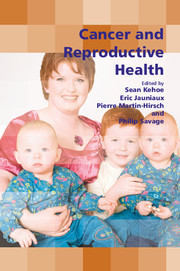Book contents
- Frontmatter
- Contents
- Participants
- Preface
- SECTION 1 Epidemiology, Genetics and Basic Principles of Chemotherapy and Radiotherapy
- SECTION 2 Fertility Issues and Paediatric Cancers
- SECTION 3 Gynaecological Cancers and Precancer
- 9 Management of cervical intraepithelial neoplasia during pregnancy
- 10 Impact of LLETZ on subsequent pregnancies
- 11 Ovarian masses and malignancies
- 12 Cervical and endometrial cancer in relation to pregnancy
- SECTION 4 Diagnostic Dilemmas
- SECTION 5 The Placenta
- SECTION 6 Non-Gynaecological Cancers
- SECTION 7 Multidisciplinary Care and Service Provision
- SECTION 8 Consensus Views
- Index
10 - Impact of LLETZ on subsequent pregnancies
from SECTION 3 - Gynaecological Cancers and Precancer
Published online by Cambridge University Press: 05 October 2014
- Frontmatter
- Contents
- Participants
- Preface
- SECTION 1 Epidemiology, Genetics and Basic Principles of Chemotherapy and Radiotherapy
- SECTION 2 Fertility Issues and Paediatric Cancers
- SECTION 3 Gynaecological Cancers and Precancer
- 9 Management of cervical intraepithelial neoplasia during pregnancy
- 10 Impact of LLETZ on subsequent pregnancies
- 11 Ovarian masses and malignancies
- 12 Cervical and endometrial cancer in relation to pregnancy
- SECTION 4 Diagnostic Dilemmas
- SECTION 5 The Placenta
- SECTION 6 Non-Gynaecological Cancers
- SECTION 7 Multidisciplinary Care and Service Provision
- SECTION 8 Consensus Views
- Index
Summary
Background
During the past few decades, the incidence of cervical intraepithelial neoplasia (CIN) and microinvasive cervical cancer (FIGO stage IA1) in younger women has increased in Western countries. In many women, diagnosis and treatment of CIN occur before the completion or even the beginning of their family.
Well-organised cervical screening with appropriate treatment of screen-detected intraepithelial lesions can reduce cervical cancer incidence by up to 80%. The introduction of systematic call and recall screening programmes in the UK over the past 20 years has resulted in a profound decrease in the incidence of invasive cervical cancer as preinvasive lesions can be detected by the screening programme and treated appropriately.
There are several methods for the treatment of the cervical precancer. Cold knife conisation (CKC) is known to be associated with adverse fertility- and pregnancy-related effects. It also has the disadvantage of requiring general anaesthesia and hospitalisation. For this reason, in the 1970s and 1980s outpatient ablative methods of treatment (electrocoagulation, cryotherapy, laser ablation) replaced cone biopsy for the great majority of cases. Large loop excision of the transformation zone (LLETZ) (also known as loop electrosurgical excision procedure [LEEP] in the USA) was introduced in the late 1980s and has now become the most popular method of treatment for CIN, largely as a result of its simplicity, its efficiency as an outpatient or ‘office’ technique, and the facility to comprehensively examine histologically the excised transformation zone.
Keywords
- Type
- Chapter
- Information
- Cancer and Reproductive Health , pp. 115 - 124Publisher: Cambridge University PressPrint publication year: 2008

